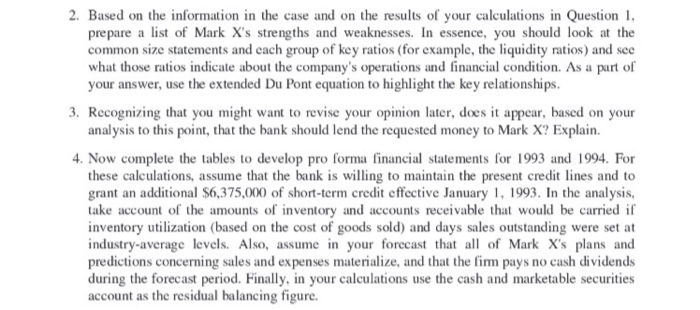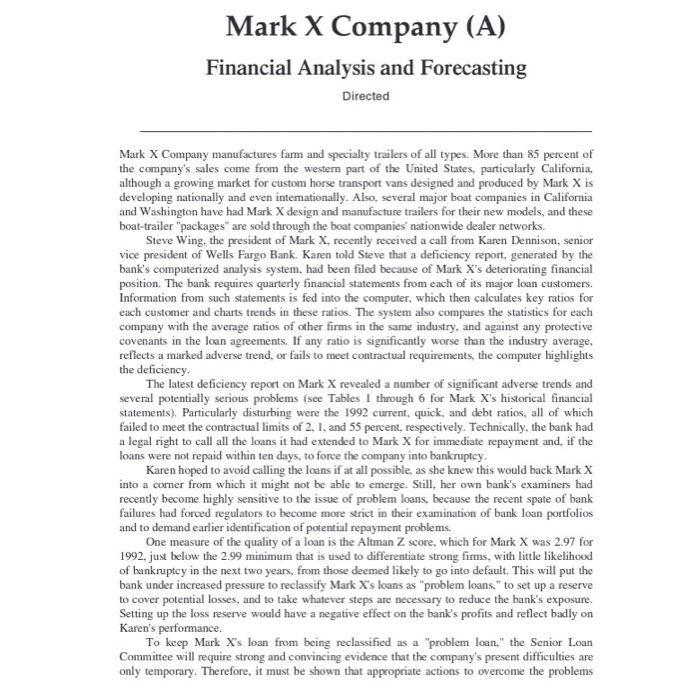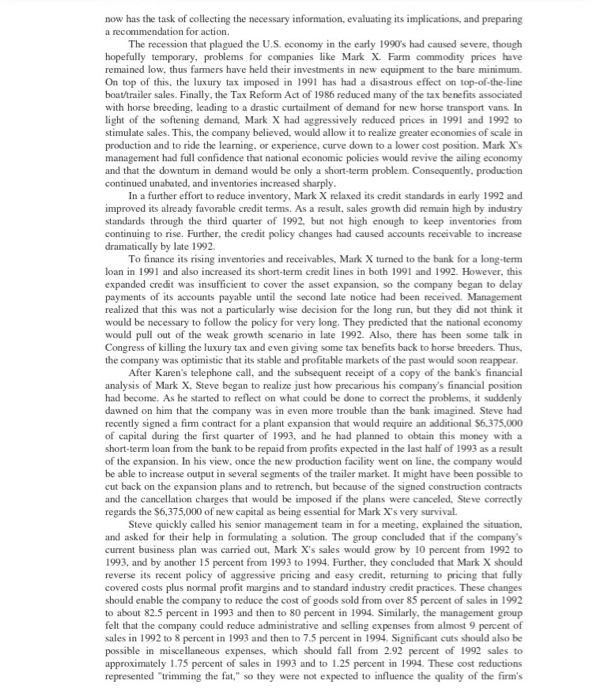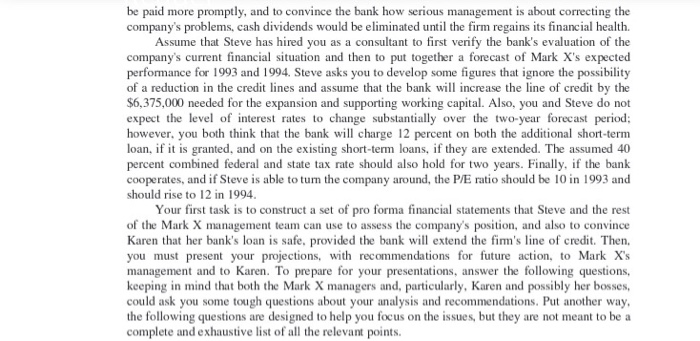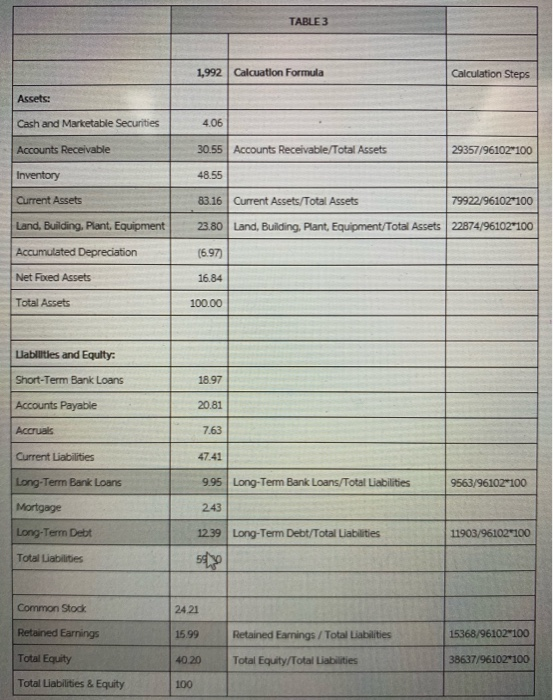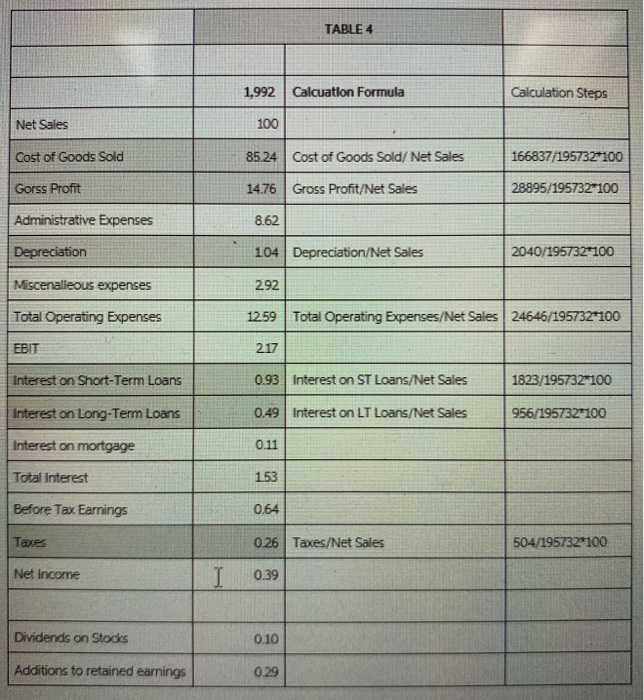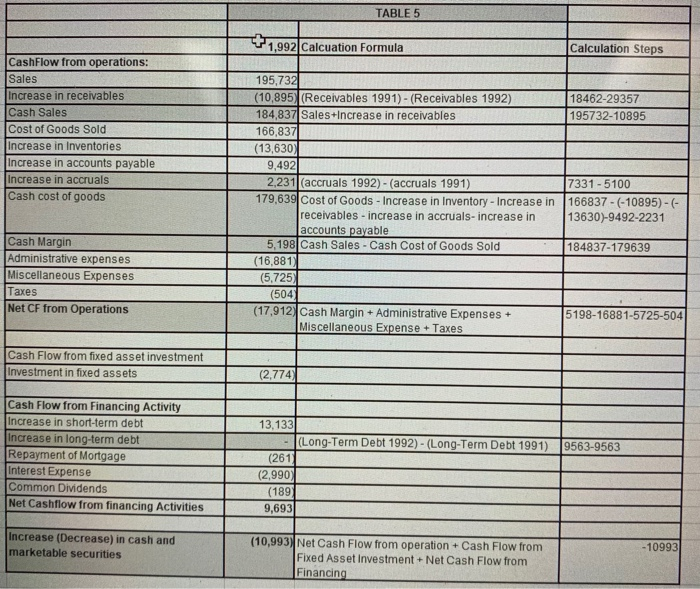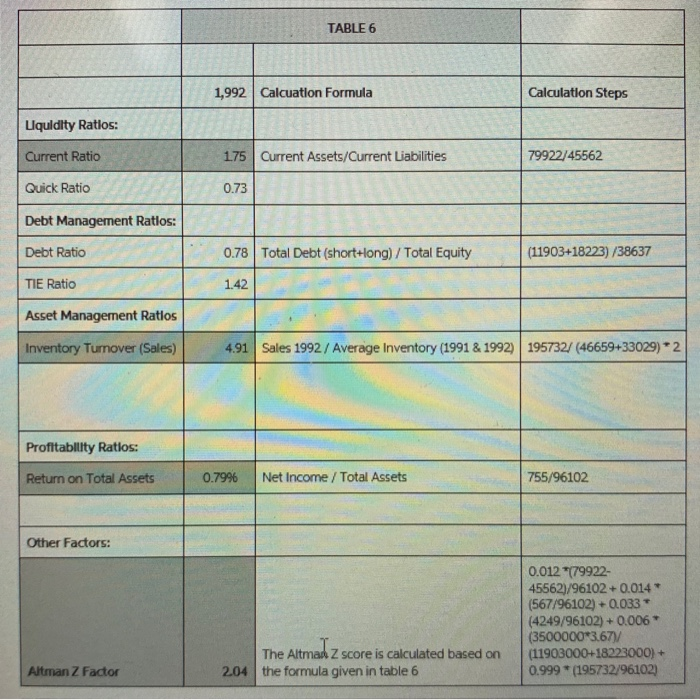2. Based on the information in the case and on the results of your calculations in Question 1, prepare a list of Mark X's strengths and weaknesses. In essence, you should look at the common size statements and each group of key ratios (for example, the liquidity ratios) and see what those ratios indicate about the company's operations and financial condition. As a part of your answer, use the extended Du Pont equation to highlight the key relationships. 3. Recognizing that you might want to revise your opinion later, does it appear, based on your analysis to this point, that the bank should lend the requested money to Mark X? Explain. 4. Now complete the tables to develop pro forma financial statements for 1993 and 1994. For these calculations, assume that the bank is willing to maintain the present credit lines and to grant an additional $6,375,000 of short-term credit effective January 1, 1993. In the analysis, take account of the amounts of inventory and accounts receivable that would be carried if inventory utilization (based on the cost of goods sold) and days sales outstanding were set at industry-average levels. Also, assume in your forecast that all of Mark X's plans and predictions concerning sales and expenses materialize, and that the firm pays no cash dividends during the forecast period. Finally, in your calculations use the cash and marketable securities account as the residual balancing figure. Mark X Company (A) Financial Analysis and Forecasting Directed Mark X Company manufactures farm and specialty trailers of all types. More than 85 percent of the company's sales come from the western part of the United States, particularly California, although a growing market for custom horse transport vans designed and produced by Mark X is developing nationally and even intemationally. Also, several major boat companies in California and Washington have had Mark X design and manufacture trailers for their new models, and these boat-trailer "packages are sold through the boat companies' nationwide dealer networks. Steve Wing, the president of Mark X, recently received a call from Karen Dennison, senior vice president of Wells Fargo Bank. Karen told Steve that a deficiency report, generated by the bank's computerized analysis system, had been filed because of Mark X's deteriorating financial position. The bank requires quarterly financial statements from each of its major loan customers. Information from such statements is fed into the computer, which then calculates key ratios for each customer and charts trends in these ratios. The system also compares the statistics for each company with the average ratios of other firms in the same industry, and against any protective covenants in the loan agreements. If any ratio is significantly worse than the industry average, reflects a marked adverse trend, or fails to meet contractual requirements, the computer highlights the deficiency. The latest deficiency report on Mark X revealed a number of significant adverse trends and several potentially serious problems (see Tables I through 6 for Mark X's historical financial statements). Particularly disturbing were the 1992 current, quick, and debt ratios, all of which failed to meet the contractual limits of 2, 1, and 55 percent, respectively. Technically, the bank had a legal right to call all the loans it had extended to Mark X for immediate repayment and, if the loans were not repaid within ten days, to force the company into bankruptcy. Karen hoped to avoid calling the loans if at all possible, as she knew this would back Mark X into a corner from which it might not be able to emerge. Still, her own bank's examiners had recently become highly sensitive to the issue of problem loans, because the recent spate of bank failures had forced regulators to become more strict in their examination of bank loan portfolios and to demand earlier identification of potential repayment problems. One measure of the quality of a loan is the Altman Z score, which for Mark X was 2.97 for 1992. just below the 2.99 minimum that is used to differentiate strong firms, with little likelihood of bankruptcy in the next two years, from those deemed likely to go into default. This will put the bank under increased pressure to reclassify Mark X's loans as "problem loans," to set up a reserve to cover potential losses, and to take whatever steps are necessary to reduce the bank's exposure. Setting up the loss reserve would have a negative effect on the bank's profits and reflect badly on Karen's performance. To keep Mark X's loan from being reclassified as a "problem loan," the Senior Loan Committee will require strong and convincing evidence that the company's present difficulties are only temporary. Therefore, it must be shown that appropriate actions to overcome the problems now has the task of collecting the necessary information, evaluating its implications, and preparing a recommendation for action. The recession that plagued the U.S. economy in the early 1990's had caused severe, though hopefully temporary, problems for companies like Mark X Farm commodity prices have remained low, thus farmers have held their investments in new equipment to the bure minimum. On top of this, the luxury tax imposed in 1991 has had a disastrous effect on top-of-the-line boat trailer sales. Finally, the Tax Reform Act of 1986 reduced many of the tax benefits associated with horse breeding, leading to a drastic curtailment of demand for new horse transport vans. In light of the softening demand, Mark X had aggressively reduced prices in 1991 and 1992 to stimulate sales. This, the company believed, would allow it to realize greater economies of scale in production and to ride the learning, or experience, curve down to a lower cost position. Mark Xs management had full confidence that national economic policies would revive the ailing economy and that the downtum in demand would be only a short-term problem. Consequently, production continued unabated, and inventories increased sharply. In a further effort to reduce inventory, Mark X relaxed its credit standards in early 1992 and improved its already favorable credit terms. As a result, sales growth did remain high by industry standards through the third quarter of 1992, but not high enough to keep inventories from continuing to rise. Further, the credit policy changes had caused accounts receivable to increase dramatically by late 1992. To finance its rising inventories and receivables, Mark X turned to the bank for a long-term loan in 1991 and also increased its short-term credit lines in both 1991 and 1992. However, this expanded credit was insufficient to cover the asset expansion, so the company began to delay payments of its accounts payable until the second late notice had been received. Management realized that this was not a particularly wise decision for the long run, but they did not think it would be necessary to follow the policy for very long. They predicted that the national economy would pull out of the weak growth scenario in late 1992. Also, there has been some talk in Congress of killing the luxury tax and even giving some tax benefits back to horse breeders. Thus, the company was optimistic that its stable and profitable markets of the past would soon reappear. After Karen's telephone call, and the subsequent receipt of a copy of the bank's financial analysis of Mark X, Steve began to realize just how precarious his company's financial position had become. As he started to reflect on what could be done to correct the problems, it suddenly dawned on him that the company was in even more trouble than the bank imagined. Steve had recently signed a fim contract for a plant expansion that would require an additional S6,375.000 of capital during the first quarter of 1993, and he had planned to obtain this money with a short-term loan from the bank to be repaid from profits expected in the last half of 1993 as a result of the expansion. In his view, once the new production facility went on line, the company would be able to increase output in several segments of the trailer market. It might have been possible to cut back on the expansion plans and to retrench, but because of the signed construction contracts and the cancellation charges that would be imposed if the plans were canceled, Steve correctly regards the S6,375,000 of new capital as being essential for Mark X's very survival Steve quickly called his senior management team in for a meeting, explained the situation, and asked for their help in formulating a solution. The group concluded that if the company's current business plan was carried out, Mark X's sales would grow by 10 percent from 1992 to 1993, and by another 15 percent from 1993 to 1994. Further, they concluded that Mark X should reverse its recent policy of aggressive pricing and easy credit, returning to pricing that fully covered costs plus normal profit margins and to standard industry credit practices. These changes should enable the company to reduce the cost of goods sold from over 85 percent of sales in 1992 to about 82.5 percent in 1993 and then to 80 percent in 1994. Similarly, the management group felt that the company could reduce administrative and selling expenses from almost 9 percent of sales in 1992 to 8 percent in 1993 and then to 75 percent in 1994. Significant cuts should also be possible in miscellaneous expenses, which should fall from 2.92 percent of 1992 sales to approximately 1.75 percent of sales in 1993 and to 1.25 percent in 1994. These cost reductions represented "trimming the fat," so they were not expected to influence the quality of the firm's be paid more promptly, and to convince the bank how serious management is about correcting the company's problems, cash dividends would be eliminated until the firm regains its financial health. Assume that Steve has hired you as a consultant to first verify the bank's evaluation of the company's current financial situation and then to put together a forecast of Mark X's expected performance for 1993 and 1994. Steve asks you to develop some figures that ignore the possibility of a reduction in the credit lines and assume that the bank will increase the line of credit by the $6,375,000 needed for the expansion and supporting working capital. Also, you and Steve do not expect the level of interest rates to change substantially over the two-year forecast period; however, you both think that the bank will charge 12 percent on both the additional short-term loan, if it is granted, and on the existing short-term loans, if they are extended. The assumed 40 percent combined federal and state tax rate should also hold for two years. Finally, if the bank cooperates, and if Steve is able to tum the company around, the P/E ratio should be 10 in 1993 and should rise to 12 in 1994. Your first task is to construct a set of pro forma financial statements that Steve and the rest of the Mark X management team can use to assess the company's position, and also to convince Karen that her bank's loan is safe, provided the bank will extend the firm's line of credit. Then, you must present your projections, with recommendations for future action, to Mark X's management and to Karen. To prepare for your presentations, answer the following questions, keeping in mind that both the Mark X managers and, particularly, Karen and possibly her bosses, could ask you some tough questions about your analysis and recommendations. Put another way, the following questions are designed to help you focus on the issues, but they are not meant to be a complete and exhaustive list of all the relevant points. TABLE 3 1992 Calcuation Formula Calculation Steps Calculation Assets: Cash and Marketable Securities Accounts Receivable Inventory 4.06 30.55 Accounts Receivable/Total Assets 29357/96102*100 48.55 83.16 Current Assets/Total Assets 79922/96102-100 23.80 Land, Building, Plant, Equipment/Total Assets 22874/96102*100 Current Assets Land, Building. Plant, Equipment Accumulated Depreciation Net Foxed Assets Total Assets (6.97 16.84 100.00 Labilities and Equity: Short-Term Bank Loans Accounts Payable Accruals Current Liabilities Long-Term Bank Loans Mortgage Long-Term Debt Total Liabilities 18.97 20.81 7.63 47.41 9.95 243 1239 5 Long-Term Bank Loans/Total Liabilities 9563/96102-100 Long-Term Debt/Total Liabilities 11903/96102*100 2421 15.99 Common Stock Retained Earnings Total Equity Total Liabilities & Equity Retained Earnings / Total Liabilities Total Equity/Total Liabilities 15368/96102-100 38637/96102*100 40.20 100 TABLE4 1,992 Calcuation Formula Calculation Steps Net Sales 100 Cost of Goods Sold Gorss Profit Administrative Expenses Depreciation Miscenalleous expenses Total Operating Expenses 85.24 Cost of Goods Sold/ Net Sales 166837/195732*100 14.76 Gross Profit/Net Sales 28895/195732*100 8.62 104 Depreciation/Net Sales 2040/195732*100 292 1259 Total Operating Expenses/Net Sales 24646/195732*100 217 0.93 Interest on ST Loans/Net Sales 1823/195732*100 0.49 Interest on LT Loans/Net Sales 956/195732*100 0.11 Interest on Short-Term Loans Interest on Long-Term Loans Interest on mortgage Total Interest 153 Before Tax Earnings 0.64 Taxes 0.26 Taxes/Net Sales 504/195732*100 Net Income I 0.39 Dividends on Stocks 0.10 Additions to retained earnings 0.29 S TABLE 5 T 1,992 Calcuation Formula Calculation Steps 18462-29357 195732-10895 CashFlow from operations: Sales Increase in receivables Cash Sales Cost of Goods Sold Increase in Inventories Increase in accounts payable Increase in accruals Cash cost of goods 195,732 (10,895) (Receivables 1991) - (Receivables 1992) 184,837 Sales+Increase in receivables 166,837 (13,630 9,492 2.231 (accruals 1992) - (accruals 1991) 179,639 Cost of Goods - Increase in Inventory - Increase in receivables - increase in accruals-increase in accounts payable 5,198 Cash Sales - Cash Cost of Goods Sold (16.881) (5,725 EUR (504) (17,912)Cash Margin + Administrative Expenses + Miscellaneous Expense - Taxes 17331 - 5100 166837.(-10895)- 13630)-9492-2231 184837-179639 Cash Margin Administrative expenses Miscellaneous Expenses Taxes Net CF from Operations 5198-16881-5725-504 Cash Flow from fixed asset investment Investment in fixed assets (2,774 9563-9563 Cash Flow from Financing Activity Increase in short-term debt Increase in long-term debt Repayment of Mortgage Interest Expense Common Dividends Net Cashflow from financing Activities 13,133 - (Long-Term Debt 1992) - (Long-Term Debt 1991) (2611 (2,990) (189) 9,693 Increase (Decrease) in cash and marketable securities -10993 (10,993) Net Cash Flow from operation + Cash Flow from Fixed Asset Investment - Net Cash Flow from Financing TABLE 6 1,992 Calcuation Formula Calculation Steps Current Assets/Current Liabilities 79922/45562 | 175 0.73 Liquidity Ratios: Current Ratio Quick Ratio Debt Management Ratlos: Debt Ratio TIE Ratio Asset Management Ratlos Inventory Turnover (Sales) 0.78 Total Debt (short+long) / Total Equity (11903-18223)/38637 1.42 - . 4.91 Sales 1992 / Average Inventory (1991 & 1992) 195732/(46659+33029) * 2 Profitability Ratios: Return on Total Assets 0.79% Net Income / Total Assets 755/96102 Other Factors: 0.012 *(79922 45562/96102 +0.014 (567/96102) + 0.033* (4249/96102) + 0.006 (3500000*3.671/ (11903000+18223000) + 0.999 * (195732/96102) The Altmad z score is calculated based on 204 the formula given in table 6 Altman Z Factor 2. Based on the information in the case and on the results of your calculations in Question 1, prepare a list of Mark X's strengths and weaknesses. In essence, you should look at the common size statements and each group of key ratios (for example, the liquidity ratios) and see what those ratios indicate about the company's operations and financial condition. As a part of your answer, use the extended Du Pont equation to highlight the key relationships. 3. Recognizing that you might want to revise your opinion later, does it appear, based on your analysis to this point, that the bank should lend the requested money to Mark X? Explain. 4. Now complete the tables to develop pro forma financial statements for 1993 and 1994. For these calculations, assume that the bank is willing to maintain the present credit lines and to grant an additional $6,375,000 of short-term credit effective January 1, 1993. In the analysis, take account of the amounts of inventory and accounts receivable that would be carried if inventory utilization (based on the cost of goods sold) and days sales outstanding were set at industry-average levels. Also, assume in your forecast that all of Mark X's plans and predictions concerning sales and expenses materialize, and that the firm pays no cash dividends during the forecast period. Finally, in your calculations use the cash and marketable securities account as the residual balancing figure. Mark X Company (A) Financial Analysis and Forecasting Directed Mark X Company manufactures farm and specialty trailers of all types. More than 85 percent of the company's sales come from the western part of the United States, particularly California, although a growing market for custom horse transport vans designed and produced by Mark X is developing nationally and even intemationally. Also, several major boat companies in California and Washington have had Mark X design and manufacture trailers for their new models, and these boat-trailer "packages are sold through the boat companies' nationwide dealer networks. Steve Wing, the president of Mark X, recently received a call from Karen Dennison, senior vice president of Wells Fargo Bank. Karen told Steve that a deficiency report, generated by the bank's computerized analysis system, had been filed because of Mark X's deteriorating financial position. The bank requires quarterly financial statements from each of its major loan customers. Information from such statements is fed into the computer, which then calculates key ratios for each customer and charts trends in these ratios. The system also compares the statistics for each company with the average ratios of other firms in the same industry, and against any protective covenants in the loan agreements. If any ratio is significantly worse than the industry average, reflects a marked adverse trend, or fails to meet contractual requirements, the computer highlights the deficiency. The latest deficiency report on Mark X revealed a number of significant adverse trends and several potentially serious problems (see Tables I through 6 for Mark X's historical financial statements). Particularly disturbing were the 1992 current, quick, and debt ratios, all of which failed to meet the contractual limits of 2, 1, and 55 percent, respectively. Technically, the bank had a legal right to call all the loans it had extended to Mark X for immediate repayment and, if the loans were not repaid within ten days, to force the company into bankruptcy. Karen hoped to avoid calling the loans if at all possible, as she knew this would back Mark X into a corner from which it might not be able to emerge. Still, her own bank's examiners had recently become highly sensitive to the issue of problem loans, because the recent spate of bank failures had forced regulators to become more strict in their examination of bank loan portfolios and to demand earlier identification of potential repayment problems. One measure of the quality of a loan is the Altman Z score, which for Mark X was 2.97 for 1992. just below the 2.99 minimum that is used to differentiate strong firms, with little likelihood of bankruptcy in the next two years, from those deemed likely to go into default. This will put the bank under increased pressure to reclassify Mark X's loans as "problem loans," to set up a reserve to cover potential losses, and to take whatever steps are necessary to reduce the bank's exposure. Setting up the loss reserve would have a negative effect on the bank's profits and reflect badly on Karen's performance. To keep Mark X's loan from being reclassified as a "problem loan," the Senior Loan Committee will require strong and convincing evidence that the company's present difficulties are only temporary. Therefore, it must be shown that appropriate actions to overcome the problems now has the task of collecting the necessary information, evaluating its implications, and preparing a recommendation for action. The recession that plagued the U.S. economy in the early 1990's had caused severe, though hopefully temporary, problems for companies like Mark X Farm commodity prices have remained low, thus farmers have held their investments in new equipment to the bure minimum. On top of this, the luxury tax imposed in 1991 has had a disastrous effect on top-of-the-line boat trailer sales. Finally, the Tax Reform Act of 1986 reduced many of the tax benefits associated with horse breeding, leading to a drastic curtailment of demand for new horse transport vans. In light of the softening demand, Mark X had aggressively reduced prices in 1991 and 1992 to stimulate sales. This, the company believed, would allow it to realize greater economies of scale in production and to ride the learning, or experience, curve down to a lower cost position. Mark Xs management had full confidence that national economic policies would revive the ailing economy and that the downtum in demand would be only a short-term problem. Consequently, production continued unabated, and inventories increased sharply. In a further effort to reduce inventory, Mark X relaxed its credit standards in early 1992 and improved its already favorable credit terms. As a result, sales growth did remain high by industry standards through the third quarter of 1992, but not high enough to keep inventories from continuing to rise. Further, the credit policy changes had caused accounts receivable to increase dramatically by late 1992. To finance its rising inventories and receivables, Mark X turned to the bank for a long-term loan in 1991 and also increased its short-term credit lines in both 1991 and 1992. However, this expanded credit was insufficient to cover the asset expansion, so the company began to delay payments of its accounts payable until the second late notice had been received. Management realized that this was not a particularly wise decision for the long run, but they did not think it would be necessary to follow the policy for very long. They predicted that the national economy would pull out of the weak growth scenario in late 1992. Also, there has been some talk in Congress of killing the luxury tax and even giving some tax benefits back to horse breeders. Thus, the company was optimistic that its stable and profitable markets of the past would soon reappear. After Karen's telephone call, and the subsequent receipt of a copy of the bank's financial analysis of Mark X, Steve began to realize just how precarious his company's financial position had become. As he started to reflect on what could be done to correct the problems, it suddenly dawned on him that the company was in even more trouble than the bank imagined. Steve had recently signed a fim contract for a plant expansion that would require an additional S6,375.000 of capital during the first quarter of 1993, and he had planned to obtain this money with a short-term loan from the bank to be repaid from profits expected in the last half of 1993 as a result of the expansion. In his view, once the new production facility went on line, the company would be able to increase output in several segments of the trailer market. It might have been possible to cut back on the expansion plans and to retrench, but because of the signed construction contracts and the cancellation charges that would be imposed if the plans were canceled, Steve correctly regards the S6,375,000 of new capital as being essential for Mark X's very survival Steve quickly called his senior management team in for a meeting, explained the situation, and asked for their help in formulating a solution. The group concluded that if the company's current business plan was carried out, Mark X's sales would grow by 10 percent from 1992 to 1993, and by another 15 percent from 1993 to 1994. Further, they concluded that Mark X should reverse its recent policy of aggressive pricing and easy credit, returning to pricing that fully covered costs plus normal profit margins and to standard industry credit practices. These changes should enable the company to reduce the cost of goods sold from over 85 percent of sales in 1992 to about 82.5 percent in 1993 and then to 80 percent in 1994. Similarly, the management group felt that the company could reduce administrative and selling expenses from almost 9 percent of sales in 1992 to 8 percent in 1993 and then to 75 percent in 1994. Significant cuts should also be possible in miscellaneous expenses, which should fall from 2.92 percent of 1992 sales to approximately 1.75 percent of sales in 1993 and to 1.25 percent in 1994. These cost reductions represented "trimming the fat," so they were not expected to influence the quality of the firm's be paid more promptly, and to convince the bank how serious management is about correcting the company's problems, cash dividends would be eliminated until the firm regains its financial health. Assume that Steve has hired you as a consultant to first verify the bank's evaluation of the company's current financial situation and then to put together a forecast of Mark X's expected performance for 1993 and 1994. Steve asks you to develop some figures that ignore the possibility of a reduction in the credit lines and assume that the bank will increase the line of credit by the $6,375,000 needed for the expansion and supporting working capital. Also, you and Steve do not expect the level of interest rates to change substantially over the two-year forecast period; however, you both think that the bank will charge 12 percent on both the additional short-term loan, if it is granted, and on the existing short-term loans, if they are extended. The assumed 40 percent combined federal and state tax rate should also hold for two years. Finally, if the bank cooperates, and if Steve is able to tum the company around, the P/E ratio should be 10 in 1993 and should rise to 12 in 1994. Your first task is to construct a set of pro forma financial statements that Steve and the rest of the Mark X management team can use to assess the company's position, and also to convince Karen that her bank's loan is safe, provided the bank will extend the firm's line of credit. Then, you must present your projections, with recommendations for future action, to Mark X's management and to Karen. To prepare for your presentations, answer the following questions, keeping in mind that both the Mark X managers and, particularly, Karen and possibly her bosses, could ask you some tough questions about your analysis and recommendations. Put another way, the following questions are designed to help you focus on the issues, but they are not meant to be a complete and exhaustive list of all the relevant points. TABLE 3 1992 Calcuation Formula Calculation Steps Calculation Assets: Cash and Marketable Securities Accounts Receivable Inventory 4.06 30.55 Accounts Receivable/Total Assets 29357/96102*100 48.55 83.16 Current Assets/Total Assets 79922/96102-100 23.80 Land, Building, Plant, Equipment/Total Assets 22874/96102*100 Current Assets Land, Building. Plant, Equipment Accumulated Depreciation Net Foxed Assets Total Assets (6.97 16.84 100.00 Labilities and Equity: Short-Term Bank Loans Accounts Payable Accruals Current Liabilities Long-Term Bank Loans Mortgage Long-Term Debt Total Liabilities 18.97 20.81 7.63 47.41 9.95 243 1239 5 Long-Term Bank Loans/Total Liabilities 9563/96102-100 Long-Term Debt/Total Liabilities 11903/96102*100 2421 15.99 Common Stock Retained Earnings Total Equity Total Liabilities & Equity Retained Earnings / Total Liabilities Total Equity/Total Liabilities 15368/96102-100 38637/96102*100 40.20 100 TABLE4 1,992 Calcuation Formula Calculation Steps Net Sales 100 Cost of Goods Sold Gorss Profit Administrative Expenses Depreciation Miscenalleous expenses Total Operating Expenses 85.24 Cost of Goods Sold/ Net Sales 166837/195732*100 14.76 Gross Profit/Net Sales 28895/195732*100 8.62 104 Depreciation/Net Sales 2040/195732*100 292 1259 Total Operating Expenses/Net Sales 24646/195732*100 217 0.93 Interest on ST Loans/Net Sales 1823/195732*100 0.49 Interest on LT Loans/Net Sales 956/195732*100 0.11 Interest on Short-Term Loans Interest on Long-Term Loans Interest on mortgage Total Interest 153 Before Tax Earnings 0.64 Taxes 0.26 Taxes/Net Sales 504/195732*100 Net Income I 0.39 Dividends on Stocks 0.10 Additions to retained earnings 0.29 S TABLE 5 T 1,992 Calcuation Formula Calculation Steps 18462-29357 195732-10895 CashFlow from operations: Sales Increase in receivables Cash Sales Cost of Goods Sold Increase in Inventories Increase in accounts payable Increase in accruals Cash cost of goods 195,732 (10,895) (Receivables 1991) - (Receivables 1992) 184,837 Sales+Increase in receivables 166,837 (13,630 9,492 2.231 (accruals 1992) - (accruals 1991) 179,639 Cost of Goods - Increase in Inventory - Increase in receivables - increase in accruals-increase in accounts payable 5,198 Cash Sales - Cash Cost of Goods Sold (16.881) (5,725 EUR (504) (17,912)Cash Margin + Administrative Expenses + Miscellaneous Expense - Taxes 17331 - 5100 166837.(-10895)- 13630)-9492-2231 184837-179639 Cash Margin Administrative expenses Miscellaneous Expenses Taxes Net CF from Operations 5198-16881-5725-504 Cash Flow from fixed asset investment Investment in fixed assets (2,774 9563-9563 Cash Flow from Financing Activity Increase in short-term debt Increase in long-term debt Repayment of Mortgage Interest Expense Common Dividends Net Cashflow from financing Activities 13,133 - (Long-Term Debt 1992) - (Long-Term Debt 1991) (2611 (2,990) (189) 9,693 Increase (Decrease) in cash and marketable securities -10993 (10,993) Net Cash Flow from operation + Cash Flow from Fixed Asset Investment - Net Cash Flow from Financing TABLE 6 1,992 Calcuation Formula Calculation Steps Current Assets/Current Liabilities 79922/45562 | 175 0.73 Liquidity Ratios: Current Ratio Quick Ratio Debt Management Ratlos: Debt Ratio TIE Ratio Asset Management Ratlos Inventory Turnover (Sales) 0.78 Total Debt (short+long) / Total Equity (11903-18223)/38637 1.42 - . 4.91 Sales 1992 / Average Inventory (1991 & 1992) 195732/(46659+33029) * 2 Profitability Ratios: Return on Total Assets 0.79% Net Income / Total Assets 755/96102 Other Factors: 0.012 *(79922 45562/96102 +0.014 (567/96102) + 0.033* (4249/96102) + 0.006 (3500000*3.671/ (11903000+18223000) + 0.999 * (195732/96102) The Altmad z score is calculated based on 204 the formula given in table 6 Altman Z Factor
